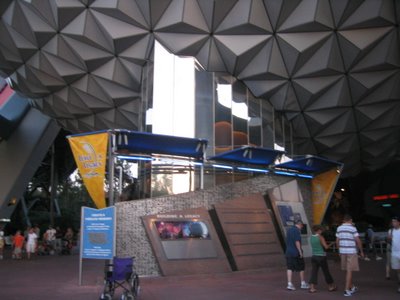
Why am I so fascinated with Epcot? Why am I so disappointed?
This clinches it: a comment by James W. Rouse, Urban Developer of the New Town of Columbia, said in his keynote address before the 1963 Urban Design Conference at Harvard University. One of the brightest minds of the era observed:
“I may hold a view that may be somewhat shocking to an audience as sophisticated as this; that the greatest piece of urban design in the United States today is Disneyland... I find more to learn in the standards that have been set and in the goals that have been achieved in the development of Disneyland than in any other piece of physical development in the country.”
And look what has happened.
I know there are people who regret what Disneyland has become, what Disney’s movie division has become, what has happened to concepts like The Disney Store and
DisneyQuest but I’d argue that they pale in comparison to the plight of Epcot.
Epcot was the last dream of Walt Disney, as everyone reading this will know. And everyone knows that, bless ’em, the executives who were left in charge after Disney died believed that they were honoring his dream by creating the EPCOT Center theme park.
Most claim they didn’t; I think they did – honor it, that is, at least in spirit. They put an emphasis on the hopes and possibilities of the future, they opened the concept to large companies to showcase their developments; they took the idea of an enclosed mall themed to the world’s nations and turned it into World Showcase.
More than that, they kept alive at least the ideals, the basic thoughts, behind Disney’s impossibly grand scheme. (So impossible that no one, not a single person on the planet, could likely have made it come to pass without Walt.) When it was presented, when it opened, through its first decade and a half of operations, EPCOT Center proudly stood as the symbol for what made The Walt Disney Company unlike any other company on earth.
It wasn’t a theme park; there weren’t all that many rides, at least by “normal” standards. It wasn’t a science center; most of its attractions were centered around ideas, not hard facts. It wasn’t all fun and games and it wasn’t all happiness and light. It was decidedly unique.
Its towering structures glistened in the Florida sun, monolithic and sometimes overpowering, as if laying claim to the future itself. Inside the gates, many guests were undoubtedly puzzled by its concept, but just as many came away enervated, eager to learn more, eager to move into their own futures with a sense that anything was possible. (Some just came away drunk, but that’s a different story.)
What made Epcot truly meaningful was that it was
so different. Twenty-five years on, it’s hard to qualify; trying to explain what made Epcot unique is like trying to explain why yellow is your favorite color; it just is.
Or, in Epcot's case, it ... was.
Now, Epcot is overrun by Disney character merchandise, by the insistence that this is fun, by the desire to be like everyone else.
The tragedy is how assertively and insistently Disney’s management in the past 10 years have forced Epcot to become like everything else. They had something that could last for the ages, something that could always be in the state of becoming, something that no one else – ever, anywhere – could duplicate.
That scared them.
I know much of what I’m writing is similar to what I’ve written before. But as I review that comment by James W. Rouse, I am saddened to see that Disney, once a force unlike any other in entertainment (or any other industry, for that matter) has become so mundane, so much like everyone else. Is there a single mind at Disney who could envision a concept so radical it would win the admiration of one of today’s most eminent scholars? Is there anyone who could dream a concept so daring that it would never be duplicated by anyone, anywhere?
There seem, instead, only to be people so scared by the idea that they are the custodians of something special that they’d rather destroy that object than protect it and care for it any longer.
As I watch Epcot become Pixar-ized and made mundane and meaningless, I am at a loss. I still love it. I love that glistening sphere of Spaceship Earth; the beautiful architecture that reminds me of a time when the future was exciting and new. I love hearing the futuristic music that makes me imagine (goofy me) a time when we’d all wear matching jumpsuits and go to work in hovercrafts. I love seeing the pristine walkways and waterways that meander past glass-and-steel structures that promise wonder and amazement. I love the concept of Epcot; I do still get excited when I return there.
But more and more, hard as it is to admit, I just get sad. I hate seeing people give up on their dreams. I really hate seeing companies, with their unlimited resources and infinite possibilities, give up on the dreams of others.
That’s terribly, terribly disappointing.






















